menu
- home
- What is the Zero Garbage Challenge?
- Garbage facts
- compost
- reduce.reuse.recycle
- ALTERNATIVES
- Zero and a Kid
- MY NON-GARBAGE
- Workshops
- Press & Coverage
- More links!
- Rose's Bio
- archive
- rss
about
What, Why and How
Video Series
Blog
Email Me
To receive updates about workshops and other zero garbage info, subscribe
Here
Video Series: Sustainability Pecha Kucha
Pecha Kucha is a form of concise presentation. I was recently part of a Sustainability symposium. We each had 20 slides, 20 seconds each. Here is the 6-minute summary of my sustainability projects.
0 notes | Permalink
2023 Non-garbage
Happy anniversary to us! 2023 was my 15th year of zero garbage, and Jake’s 10th year!
0 notes | Permalink
Happimessiness
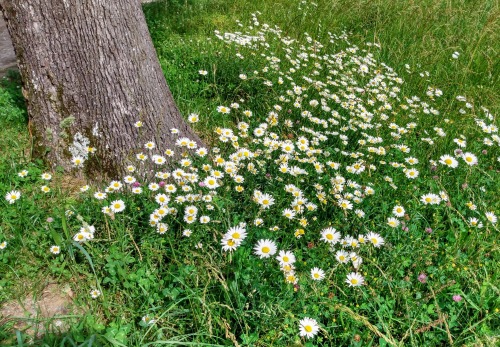
I usually write about physical garbage - the stuff we accumulate. Today I’m thinking about another aspect of my zero garbage challenge: the inner garbage. When I first stopped throwing things away, I noticed my inner garbage shifting a bit. Over time, the shifts were more noticeable. I really do feel lighter, life feels simpler. I have a smaller inventory of stuff to keep track of. I have fewer guilty thoughts about how I live in the world.
I’m not saying that I always feel that way. There are plenty of days when the state of the world induces deep sadness. There are many problems that my sustainability projects just cannot solve.
I’m reading a novel by Danzy Senna. One of the characters just said,
“You don’t get that many chances to be happy. And any stretch of happiness, by the way, only ever lasts two weeks.”
Today I’m in one of those two-week times. I’m happy. Everything is going to be okay. I feel this despite the horrors of the world around me. I feel healthy, loved, supported. I have family, friends, a community. Even the small things: my phone isn’t glitching. I haven’t lost these sunglasses yet, and they’re my favorite right now. My summer clothes feel good. Wildflowers are everywhere. There’s almost no garbage in my head right now.
At some point, the sheen will wear off and I’ll find myself taking all of that for granted again, maybe seeing some of it negatively. More mental garbage will pile up. One of the many cycles in life.
It’s times like this when I see the beauty in the cycles - both internal and external. The pandemic has shown many of us how much we bounce around the spectrum of moods, coping mechanisms, food intake, garbage production. Even our ability to care fluctuates. But the current uprising in this country is showing us that we must stand up for others. How do we do this when our resources are drained? For that matter, how do we make sustainable choices when we’ve been in a pandemic fog for so many months?
Sometimes we have energy for change. We protest, we go out there and connect, we activate, we take care of others and the earth, we make our lives more sustainable. At other times, we let the junk pile up, tune it all out, take care of ourselves first, make the impulse buys, and sink back into old habits that feel good and bad at the same time.
What I must believe is this: when I don’t have the energy to go out there and make changes, you do. And when you need to sit back and hibernate for a while, I’m out there. We are a massive group of people who care, and we keep using our times of energy and happiness for good. And we also pace ourselves.
The next time you have your two weeks of happiness, enjoy. I hope you soak it in and spread that positivity around in your own ways. And when your two weeks are over and the mess takes its turn, I hope you’re kind to yourself. Rest assured that others can take your place for a while. Let’s work together.
0 notes | Permalink
The Land of Quaran-Consumption
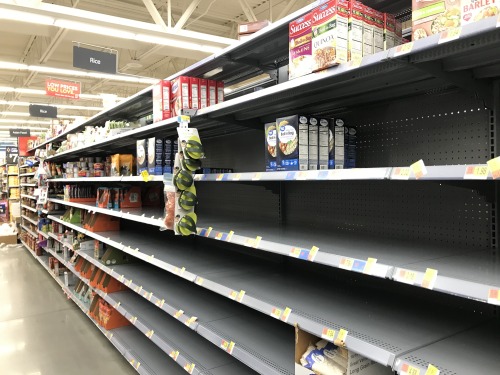
Here we are, about 6 weeks into this radically new life. We’ve passed through several phases since the pandemic began. First came disbelief and denial, when we couldn’t accept that it would happen to us. But just in case, we started to buy more stuff.
Then came shock, when our own communities and daily lives were impacted directly. Must. Stock. Up.
Then we were flooded with enough emotions to fill all of those empty grocery store shelves. It was time to break out some coping strategies. This is when the hoarder who lives inside us rose up with a fist in the air, saying “I knew you would embrace me eventually!” The inner hoarder grabbed the steering wheel and made a sharp turn into a land called Quaran-Consumption. In this newly discovered land, buying and consuming things is even more of a national pastime than it was pre-COVID.
Not only do we need to stock up on supplies, but we also have permission to cope in any way that gives us a few minutes of peace. Perhaps, in our previous lives, we had fantasies about magically tidying up, buying less junk, or reducing our garbage. The inner hoarder says, “Forget it! Times have changed!“ Now we’re shopping online, picking up curbside groceries and take-out, trying to predict what we’ll need for the next few months, and starting new hobbies and projects - anything that will keep us from scratching holes in the walls around us. Who has time for eco-conscious purchasing?
Fortunately, you do! You’re settling into some routines (and yes, they’re still mixed with wild fluctuations into coping strategies, but overall, the routines are taking over). Let’s take a breath and ponder some pandemic pitfalls and their potential solutions:
1. Me, Myself, and I: As your physical world has shrunk to the size of your home and yard, you might be noticing things about yourself that had previously been hidden by daily routines. In the past, your consumption patterns might have been distributed more widely - at home, at school, at work, at restaurants and other businesses. Today, every product you consume and every piece of garbage you create is right in front of you. You’re more keenly aware of how many snack packets you crinkle, how many times you open the fridge, even how many times you flush the toilet in a day - because it’s all happening in a much smaller bubble.
What To Do? Embrace this unusual opportunity to examine your habits. Maybe you didn’t intend to set aside the months of April and May to look deeply into your own compulsions, but here we are nonetheless. One option is to ride out this quarantine with distractions and instant gratification. Or you can scratch the surface and see what’s making you tick during this time of stress. What triggers you? What is the impact of your consumption right now? What choices are going against your morals and values? No judgment, no guilt. Just observe and learn.
2. More Stuff: Did you go a bit overboard as you stocked up? Do you find yourself buying things online as if you are personally responsible for stabilizing the economy? Online purchases have skyrocketed as Americans fill their homes with board games, toys, books, hand weights, office supplies, and the new fashion line of elastic-waist pants. At the grocery store, I’m seeing carts absolutely full of personal-care and home-cleaning supplies, paper products (you know what I’m talking about), wellness products, frozen meals, pizzas, chips, bread, pasta, beans, and shelf-stable milk alternatives (I hear oat milk is sweeping the nation).
What To Do? Pause. Really, it’s that easy. Just pause. Before buying something, give yourself some time (ideally, 24 hours) to think about it. Of course it makes sense to buy what we need right now, and yes, we need to indulge ourselves a bit. But consider whether you have something (or could borrow something) that can fill the same need. One way to force yourself to pause is to buy used items. It usually takes a bit of time to find the used item, and that is usually enough time to know whether you really need it after all.
3. Garbage In, Garbage Out: When your groceries and online purchases enter your home, you are suddenly the proud owner of pounds of packaging. What to do with it all? Even the recycling industry has taken a hit during this pandemic. Maybe you have too much on your mind to spend time figuring out how to recycle all of that packaging. Or maybe it’s not being accepted in your recycling bins. Either way, most of it is heading to the landfill.
What To Do? If you don’t buy garbage, you won’t have garbage to throw away. There are many small ways to reduce packaging. Choose a product in a recyclable can or box. Choose to spend the extra 5 minutes figuring out how to recycle or repurpose a piece of packaging. Ask online sellers to send your items in cardboard or paper instead of plastic. Every little effort adds up.
4. Landfill It Up: Are you filling your garbage can much faster than usual? You’re not alone. It’s not just the packaging. It’s also the massive quaran-cleaning projects, yard waste, and of course personal protective gear and medical waste.
What To Do? Take the time to repurpose your stuff. There are “free” pages on Craigslist and Buy Nothing Groups on Facebook. I can almost guarantee that someone wants or needs your stuff, no matter how useless you think it is. Use washable masks and gloves. Research how to clean with reusable products instead of disposables. See how much you can reduce your contribution to the landfill. You can even make it a household game, maybe a friendly competition with neighbors or friends. Document how much you throw away this week, then track the changes over the next 4-8 weeks. The winner gets an all-expenses-paid vacation to … the back yard!
For even more ideas and alternatives to disposable stuff, visit zerogarbagechallenge.info.
0 notes | Permalink
Video Series: Virtual Zero Garbage Presentation
Here is a video about my sustainability projects, especially zero garbage. Note to viewers: If you’ve already watched my 6-minute Pecha Kucha video, you can skip to 5:17 on this video because the first 5 minutes are very similar to the Pecha Kucha.
0 notes | Permalink
Video Series: DIY Composting Toilet
0 notes | Permalink
11 Years of Zero Garbage
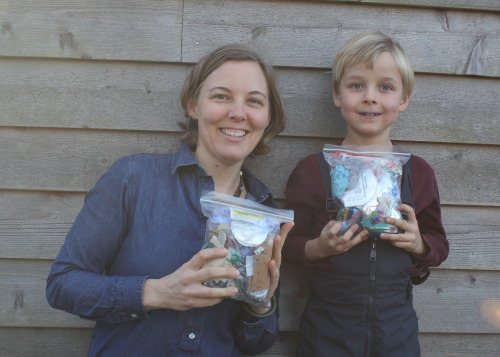
Another year of living without garbage! Here we are with the items we couldn’t recycle, reuse, or compost in 2019. We’re working each year to reduce what’s left over. We’re happy that our bags are getting smaller each year!
0 notes | Permalink
Stop Buying Stuff

During a recent road trip, I saw a bumper sticker on an 18-wheeler. “Don’t Like Semi-Trucks? Stop Buying Stuff. They’ll Go Away.” I smiled. I knew I was understanding the bumper sticker in a different way than was intended.
The bumper sticker is supposed to be a veiled threat, coated in dry humor. If you don’t want semis on the road, fine. Have it your way. But then you will have to live without your bread, eggs, bananas, and everything else you want or need. And you’ll starve. So there. Semis win.
My interpretation of the sticker is this: if we buy the bread and eggs locally, and choose a fruit that is in season in our own locale - and maybe more importantly, if we break our deep addictions to ordering junk online and having it delivered within 1-3 days (by the way - in an ironic twist, you can buy the bumper sticker on amazon) - then we will see fewer semis on the roads. And to me, that is a very good thing. You can learn more about the true costs of shipping your stuff on this handy infographic.
0 notes | Permalink
New Year’s Resolutions
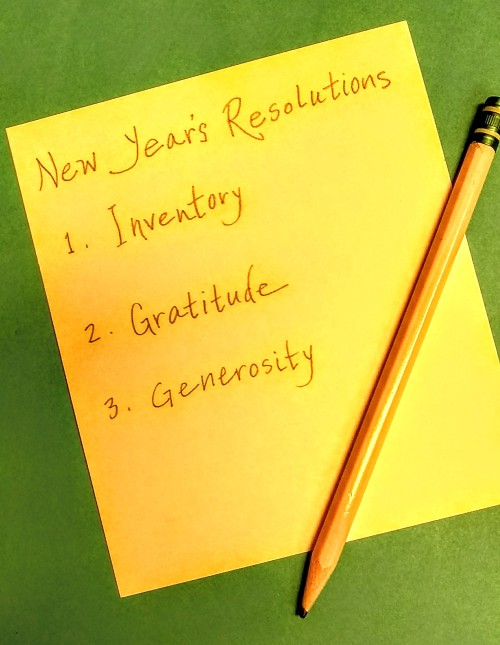
If you enjoy turning over a new leaf and starting new habits in January, here are a few ideas:
- The Daily Inventory: as you go through your day, keep your trash. At the end of the day, lay it all out and see what you think. Was any of it avoidable? What changes, if any, do you want to make? Keep this up for one week, one month, or longer.
- The Daily Gratitude: at the beginning or end of each day, make a list of all the material positions you are grateful to have. This is a gentle way of noticing just how much bounty you have, and sometimes it helps shift the focus away from the nagging feeling of needing more.
- The Daily Generosity: many resolutions are personal - eat healthier, exercise more, learn something new. This year, try something that focuses on others. Commit a small random act of kindness each day, or volunteer to help others, or learn how to care for the planet in a way you’ve never tried. Here is some inspiration from the United Nations.
0 notes | Permalink
A Perfect Package of Greed and Gratitude

During the last week, my child has been waking up each morning with one task on his mind: rush downstairs and compare how much is in his stocking vs. the other stockings. Then a formal complaint is issued. This mindset has taken me by surprise. We’re not a household that follows the typical consumption patterns. I recently cheered inside when I saw a meme that stated, “Look Around. All that clutter used to be money. All that money used to be time.” Yes! I get it! But my kid is still learning the delicate arts of generosity and minimalism.
I’m not worried because I know that a certain level of greed and desire for stuff are normal for this particular developmental stage. What’s even more fascinating to me is that I notice a bit of 6-year-old in all of us at this time of year. Are you a bit more focused on acquiring things lately? A bit more competitive with friends or family? A bit more sensitive to feeling excluded? Let’s say hello to our inner 6-year-olds and use our grown-up cognition to find balance and be more mindful this holiday season…
Comparing and Competing - 6-year olds have a new social awareness that causes them to compare themselves (and their stuff) with others. Maybe your inner child is checking out the neighbor’s christmas light display and determining how many more strands you need, or looking through catalogues to see just how sparkly your centerpiece needs to be this year. Maybe you’re even comparing yourself to last year’s self. Don’t worry, your inner 6-year-old is not just maliciously competitive. This comes from a strong need to feel accepted.
Desire for Acceptance - Young children are finding their way into a complex social world that lasts a lifetime. What we do in this world is viewed and judged by others. We all want a firm and safe place within our community, a sense of belonging, a sense of being accepted for who we are. Our inner 6-year-old feels it so strongly that we’ll try almost anything to feel accepted - even to the point of over-spending on gifts or buying things outside of our values just to feel like we’re keeping up and being accepted. Meanwhile, our adult logic knows that true acceptance does not come from competition or acquisition.
Collecting and Gathering - Collections are important to 6-year-olds. The piles of stuff give them a feeling of power and help them establish who they are and what they like. This promotes a sense of uniqueness and ownership, gives them a place in the world. Sound familiar? Who doesn’t like coming home, looking around, and seeing all of the small and large belongings that feel so comforting? Our collections are what make a house feel like a home, and what make our own home feel more personalized than someone else’s home. Of course, this is the time of year when the outside world is telling us to stock up like frantic packrats heading into an endless winter. Our adult voice can calm the urge to pile things in every corner. We can create other types of collections, like memories or memorabilia. Or even just rearrange the objects that we already own.
I always appreciate the lessons that I learn from my kid and the other people around me. We are all a beautiful mix of youthful urges and wisdom, of greed and gratitude, no matter how old we are. We are all learning together how to take care of each other and the world. Knowing that others learn from me as well, I’m trying extra hard to focus on how great it feels to give to others and to be grateful for what I have. I am extremely fortunate to have this bounty in my life.
0 notes | Permalink
Gratitude
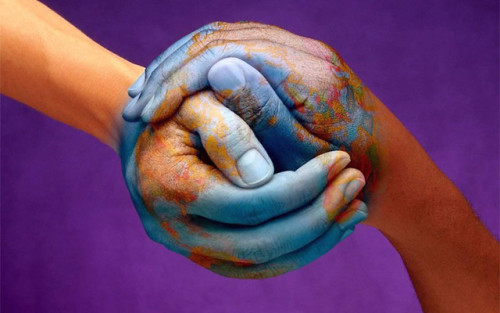
earth by bottlemagic23 on flickr
My family is celebrating Thanks Giving Day, and I’m thinking of all the people who have inspired me during my past decade of zero garbage and sustainability projects.
I’m sure it all began in my childhood with the constant, underlying messages from Mother Earth News and back-to-the-land books that were lying around the house. So my first order of thanks is to my family and neighbors who experimented with some interesting “sustainability projects” well before the term was popularized.
Back when I first began researching zero garbage in 2008, I could not find many people posting about it online. The resources that I did find were very exciting. I learned about a couple in New Zealand who completed a year without garbage in 2008 and I also got ideas from a family in England working to reduce their impact.
I read about a family that spent 18 days in Australia picking up beach trash. I read about a man who kept all his trash for a year, piling it up in his basement. And I read about a couple in Oregon who started a year without garbage just 7 months after I did. All of these people around the world felt like my people.
A few months after I officially launched the Zero Garbage Challenge, I saw The Story of Stuff, a video that opened my eyes to the truths about our consumption and waste stream. Then a new documentary was released: No Impact Man. I felt so energized because there was someone else out there working on an even more out-of-the-box project.
In 2010, I found out about the 100 Thing Challenge. I didn’t fully undertake the challenge, but I definitely understood the overlap between reducing garbage and reducing possessions. Several years later, a documentary called Minimalism arrived to remind me that my sustainability projects are all actually fueled by and supported by my desire to have and use less of everything.
All of these people provided such helpful, interesting, and inspiring information that I couldn’t help but ponder the power of sharing information. I was, at the beginning, a very reluctant blogger and public speaker. But I forged ahead with sharing my stories because I had gained so much from others along the way. And I continue to gain inspiration and ideas from all of you who I interact with through email, presentations, and workshops. Thank you for what you do and for being part of a network of inspiration.
0 notes | Permalink



